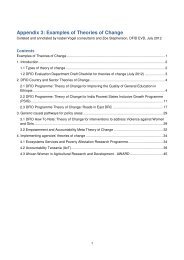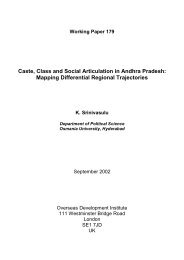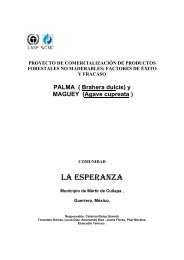Full Report - Research for Development - Department for ...
Full Report - Research for Development - Department for ...
Full Report - Research for Development - Department for ...
You also want an ePaper? Increase the reach of your titles
YUMPU automatically turns print PDFs into web optimized ePapers that Google loves.
Appendix 2.1: Inclusion and exclusion criteria<br />
Criterion Inclusion Exclusion<br />
Types of studies Randomised controlled trials<br />
Types of<br />
participants<br />
Types of<br />
intervention<br />
Types of<br />
outcomes<br />
Non-randomised controlled trials<br />
Observational studies with control<br />
groups<br />
Longitudinal time series studies<br />
Systematic reviews of these<br />
interventions<br />
Economic evaluations and modelling<br />
studies of relevant interventions<br />
Qualitative evaluations looking at<br />
implementation of relevant<br />
interventions<br />
Studies including:<br />
Mothers and/or infants up to age of 24<br />
months<br />
AND<br />
poor populations;<br />
AND<br />
urban, or semi-urban, or peri-urban<br />
settings<br />
AND<br />
low income and lower middle income<br />
countries 18<br />
Studies on interventions broadly defined<br />
as actions concerned with improving the<br />
access, utilisation or effectiveness of<br />
maternal and infant health services in<br />
areas serving urban poor populations<br />
Studies which have one or more of the<br />
following indicators as outcomes:<br />
maternal, infant, neonatal, perinatal,<br />
post-neonatal mortality, and still-birth;<br />
severe acute maternal morbidity (SAMM)<br />
(haemorrhage, dystocia, hypertension,<br />
sepsis, incomplete abortion, Caesarean<br />
section (CS), hysterectomy, and blood<br />
transfusion)<br />
Appendix 2.1<br />
Editorial, commentaries or<br />
book reviews<br />
Policy analyses<br />
Qualitative secondary<br />
analyses<br />
Studies that include only:<br />
Children aged more than<br />
24 months<br />
What are the effects of different models of delivery <strong>for</strong> improving maternal and infant<br />
health outcomes <strong>for</strong> poor people in urban areas in low income and lower middle income<br />
countries? 75<br />
OR<br />
non-poor urban<br />
populations<br />
OR<br />
rural settings<br />
OR<br />
upper middle-income<br />
countries<br />
countries in Europe<br />
Studies that did not clearly<br />
distinguish effects from<br />
other non-targeted health<br />
interventions, such as the<br />
provision of potable water<br />
Studies which have one or<br />
more of the following<br />
indicators as outcomes:<br />
Children mortality where<br />
the age is not specified<br />
Maternal morbidity other<br />
than SAMM<br />
18 http://data.worldbank.org/about/country-classifications/country-and-lending-groups









